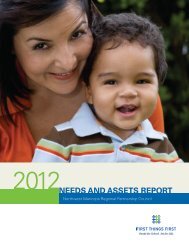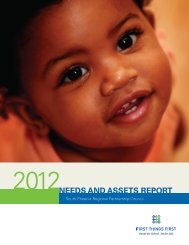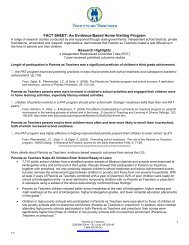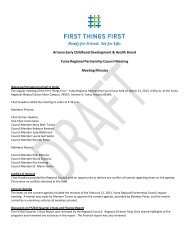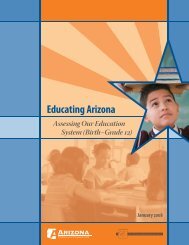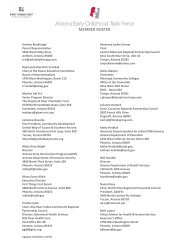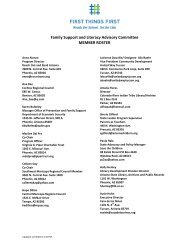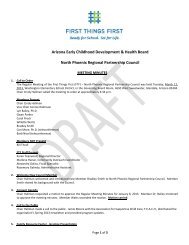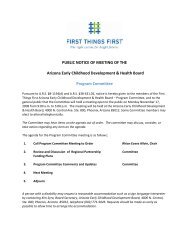White Mountain Apache Tribe Regional ... - First Things First
White Mountain Apache Tribe Regional ... - First Things First
White Mountain Apache Tribe Regional ... - First Things First
You also want an ePaper? Increase the reach of your titles
YUMPU automatically turns print PDFs into web optimized ePapers that Google loves.
<strong>White</strong> <strong>Mountain</strong> <strong>Apache</strong> <strong>Tribe</strong> <strong>Regional</strong> Partnership CouncilREGIONAL COUNCIL 2010 Allocation: $426,450WHITE MOUNTAIN APACHE TRIBE REGIONAL PARTNERSHIP COUNCILFUNDING PLANJuly 1, 2009 – June 30, 2012OVERVIEW OF THE THREE YEAR STRATEGIC DIRECTIONSection 1:<strong>Regional</strong> Needs and AssetsThe <strong>White</strong> <strong>Mountain</strong> <strong>Apache</strong> <strong>Tribe</strong> <strong>Regional</strong> Partnership Council is responsible for creating asystem for educational development and health in the region encompassed by the boundariesof the Fort <strong>Apache</strong> Indian Reservation, home of the <strong>White</strong> <strong>Mountain</strong> <strong>Apache</strong> <strong>Tribe</strong>. The regionconsists of approximately 1.6 million acres of some of the most pristine land in Arizona.According to the 2000 Census, there are approximately 12,377 people living in the region; 1,522are children age zero to five. Similar to trends seen in other Native communities, thepopulation is very young, which may be an effect of the increased number of teen pregnanciesamong the population.Residents of the Fort <strong>Apache</strong> Indian Reservation tend to have lower incomes and a higherpoverty rate than both the state and nation. According to the Bureau of Indian Affairs laborstatistics, 51% of the labor force in the region is unemployed. Not only does the region’sunemployment rate exceed both the state and nation’s numbers, the number of single-parenthouseholds exceeds the state and nation with 39% being headed solely by a female and 8%solely by a male. In addition, 65% of grandparents in the region are the primary caregivers forchildren age zero to five. Both single-parent households and households where grandparentsare the primary caregivers tend to have lower household incomes than households with twoincomes.According to the 2000 U.S. Census, there are 1,522 children ages birth through five living in theregion. Currently, there are 10 child care providers including: two day care centers, one HeadStart program, and seven special needs preschool classes run through the <strong>White</strong>river UnifiedSchool District. In total, these 10 programs have the capacity to serve 490 children, only 32% ofthe population of children birth through age five. As a result, a majority of parents of youngchildren have to rely on family and friends to care for their children during working hours.Historically, Native American adults and children tend to suffer greater health problems thanthe rest of the population. Annually, the Head Start program provides dental and healthscreenings for all children enrolled in the program. The 2007 Head Start screenings showed79% of children age three to five had active dental disease and only 82% of those children withactive dental disease received treatment. Of the children screened, 56% were consideredoverweight/obese for their age. This number far exceeds the Center for Disease Control’sHealthy People 2010 target of 5% for childhood obesity. Any Native American residing in theregion can access free healthcare through the Indian Health Service hospital in <strong>White</strong>river,Arizona. Unfortunately, patients must wait hours to be seen by a physician. If cases are severe,patients are sent to urban health care providers for more sophisticated treatment. Dental careat the Indian Health Service hospital focuses on triaging the most severe cases in the1
<strong>White</strong> <strong>Mountain</strong> <strong>Apache</strong> <strong>Tribe</strong> <strong>Regional</strong> Partnership CouncilREGIONAL COUNCIL 2010 Allocation: $426,450community and places little emphasis on prevention. As a result, children and adults seekingroutine cleanings or preventative care are usually last on the priority list.Like other communities, system coordination is an area in need of improvement. Severalagencies such as WIC, Head Start, Child Find and the local day care centers provide services tochildren age birth to five as well as their families. Unfortunately, these agencies have very littleinfrastructure to ensure ongoing communication between programs when providing services tothe same children. As a result, parents and caregivers feel frustrated when requiring servicesfrom more than one agency. Coordination among agencies would help to streamline servicesfor children and their families.Language development is critical to ensuring children are ready to learn when enteringkindergarten. The <strong>White</strong>river Unified School District conducts the Peabody Picture VocabularyTest to determine if children in kindergarten are on track for language development. Onaverage, children in the region are approximately two years behind benchmark in terms of theirlanguage development. This indicates that a five-year-old in kindergarten has the languagecapacity of a three-year-old. This makes learning difficult for the child and teaching difficult forthe teacher. As a result, pre-kindergarten programs emphasizing language development are anessential asset to the community.Although there are several areas where improvements could be made, the region has manyassets that could prove beneficial in the development of an early childhood health anddevelopment system. <strong>First</strong>, the region places a large emphasis on the importance of family and,specifically, the extended family. The strong family network ensures most children are caredfor by their close family members. This is a fundamental asset as the child grows and develops.Second, there are many resources for new moms or parents of young children. The IndianHealth Service provides training and classes for moms- and dads-to-be in a wide variety ofareas. The Women, Infant, and Children (WIC) office also provides training and has a myriad ofbrochures for moms receiving services through the WIC office. In addition, other organizationssuch as the Tribal Day Care and the Child Find Program offer monthly seminars and trainings forparents of children receiving services from either department.Lastly, there are many opportunities for continued education for child care providers.Northland Pioneer College, the local community college, provides classes in <strong>White</strong>river forcommunity members. Additionally, Northern Arizona University has a satellite campus in<strong>White</strong>river that provides community members the opportunity to earn a bachelor’s degree inearly childhood development without having to relocate. Financial assistance is providedthrough the <strong>White</strong> <strong>Mountain</strong> <strong>Apache</strong> <strong>Tribe</strong>’s Office of Higher Education. Tribal members qualifyfor $5,000.00 annually in scholarships.The <strong>White</strong> <strong>Mountain</strong> <strong>Apache</strong> <strong>Tribe</strong> <strong>Regional</strong> Partnership Council understands that to ensurechildren are able to succeed in school and in life; the gaps in services need to begin to close.The <strong>White</strong> <strong>Mountain</strong> <strong>Apache</strong> <strong>Tribe</strong> <strong>Regional</strong> Partnership Council will work to build on theexisting regional assets to create a system that ensures all children age birth to five are healthyand ready to learn when they enter kindergarten.2
<strong>White</strong> <strong>Mountain</strong> <strong>Apache</strong> <strong>Tribe</strong> <strong>Regional</strong> Partnership CouncilREGIONAL COUNCIL 2010 Allocation: $426,450Given the findings of the <strong>Regional</strong> Needs and Assets Report, the <strong>White</strong> <strong>Mountain</strong> <strong>Apache</strong> <strong>Tribe</strong><strong>Regional</strong> Partnership Council has identified four major needs of children and families of childrenbirth through five and has prioritized them based on availability of resources to currently meetthose needs.1) Increased access to parent and provider training and/or education. Given the highunemployment rates, high number of teen parents and the large number of childrenreceiving child care from extended family networks, the <strong>White</strong> <strong>Mountain</strong> <strong>Apache</strong> <strong>Tribe</strong><strong>Regional</strong> Partnership Council recognizes a significant need for providing services andinformation to those parents and child care providers who are not currently receivingthe necessary support they need to ensure they are providing quality child care. As aresult, the <strong>White</strong> <strong>Mountain</strong> <strong>Apache</strong> <strong>Tribe</strong> <strong>Regional</strong> Partnership Council’s number onegoal will be for increased family support.2) Children age 6 months through five years have very high rates of active dental disease.As a result, there is a significant need for dental disease prevention for young children inthe community. Like most other Native American communities, people residing on theFort <strong>Apache</strong> Indian Reservation have much higher incidences and rates of chronicdiseases. Since a majority of children who receive dental screenings through the HeadStart program have active dental disease, the <strong>White</strong> <strong>Mountain</strong> <strong>Apache</strong> <strong>Tribe</strong> <strong>Regional</strong>Partnership Council has determined this is an area where a significant amount of goodcan be done in a short amount of time with the limited funds that are available. Otherhealth problems in the community exist but given the affect persistent dental diseasehas on a child’s ability to concentrate and participate in the learning process while inchild care, pre-school and onto kindergarten, the <strong>White</strong> <strong>Mountain</strong> <strong>Apache</strong> <strong>Tribe</strong><strong>Regional</strong> Partnership Council has placed high priority on preventive dental care.3) Lack of language and literacy-rich environments for children birth through five to growand develop. The <strong>White</strong> <strong>Mountain</strong> <strong>Apache</strong> <strong>Tribe</strong> <strong>Regional</strong> Needs and Assets Reportrevealed that children are, on average, two years behind in language and vocabularydevelopment by the time they enter kindergarten (Peabody Picture Vocabulary TestScores for 2007). As a result, teachers must spend a majority of their time getting theirstudents caught up rather than helping the child progress in his/her educationaldevelopment. As a result, the <strong>White</strong> <strong>Mountain</strong> <strong>Apache</strong> <strong>Tribe</strong> <strong>Regional</strong> PartnershipCouncil feels that every child needs to be prepared, in terms of language and vocabularydevelopment, when they enter kindergarten so that the child does not have to playcatch-up from the first day he/she enters a formal classroom setting. The goal forlanguage and literacy development in this region will be for “<strong>First</strong> <strong>Things</strong> <strong>First</strong> toincrease the availability, quality and diversity of relevant resources that supportlanguage and literacy development for young children and their families.” By addressing3
<strong>White</strong> <strong>Mountain</strong> <strong>Apache</strong> <strong>Tribe</strong> <strong>Regional</strong> Partnership CouncilREGIONAL COUNCIL 2010 Allocation: $426,450this particular need, the <strong>White</strong> <strong>Mountain</strong> <strong>Apache</strong> <strong>Tribe</strong> <strong>Regional</strong> Partnership Councilhopes to bring children closer to being ready to learn when they enter kindergarten.4) Increased participation in the U.S. Census for future funding opportunities andincreased awareness about <strong>First</strong> <strong>Things</strong> <strong>First</strong> and early childhood development in theregion. Like other areas in the state, up until now very little emphasis has been placedon creating a comprehensive early childhood system. In order to promote the visionand mission of <strong>First</strong> <strong>Things</strong> <strong>First</strong> as well as highlight the importance of investing inchildren while they are young, the <strong>White</strong> <strong>Mountain</strong> <strong>Apache</strong> <strong>Tribe</strong> <strong>Regional</strong> PartnershipCouncil will create strategies that will not only build awareness but will also fosterpolitical will for early childhood initiatives within the region. Additionally, the <strong>White</strong><strong>Mountain</strong> <strong>Apache</strong> <strong>Tribe</strong> <strong>Regional</strong> Partnership Council identified a significant need forincreased census participation throughout the region. Historically, Native Americangroups have been resistant to participating in the census yet a majority of federal andstate funding comes directly from census numbers. As a result, the <strong>White</strong> <strong>Mountain</strong><strong>Apache</strong> <strong>Tribe</strong> <strong>Regional</strong> Partnership Council will expand efforts to increase publicawareness of early childhood development and health efforts as well as increaseinvolvement in the U.S. Census among the target population.4
<strong>White</strong> <strong>Mountain</strong> <strong>Apache</strong> <strong>Tribe</strong> <strong>Regional</strong> Partnership CouncilREGIONAL COUNCIL 2010 Allocation: $426,450Section 2:Prioritized Goals and Key MeasuresPriority 1: Family SupportNeed: Increased access to parent and provider training and/or educationGoal #11: FTF will coordinate and integrate with existing education and information systems toexpand families’ access to high quality, diverse and relevant information and resources tosupport their child’s optimal growth.Key Measure(s) Utilized:1) Percentage of families with children birth through age five who report they are satisfiedwith the accessibility of information and resources on child development and health2) Percentage of families with children birth through age five who report they are competentand confident about their ability to support their child’s safety, health and well-beingPriority 2: Dental Disease PreventionNeed: Children zero to five have high rates of dental disease; therefore, the need is to reducethe incidence of dental disease among children zero to five years old.Goal #4: FTF will collaborate with existing Arizona early childhood health care systems toimprove children’s access to quality health care.Key Measure(s) Utilized:1) Total number and percentage of children receiving appropriate and timely oral healthvisitsPriority 3: Language and Literacy DevelopmentNeed: Lack of language- and literacy-rich environments for children zero to five to be able togrow and developGoal #12: FTF will increase the availability, quality and diversity of relevant resources thatsupport language and literacy development for young children and their families.Key Measure(s) Utilized:1) Percentage of families with children birth through age five who report they maintainlanguage- and literacy-rich home environments (e.g. children hear language throughout5
<strong>White</strong> <strong>Mountain</strong> <strong>Apache</strong> <strong>Tribe</strong> <strong>Regional</strong> Partnership CouncilREGIONAL COUNCIL 2010 Allocation: $426,450the day, children have opportunities for listening and talking with family members,books and other literacy tools and materials are available and accessible to children)2) Percentage of families with children birth through five who report reading to theirchildren daily in their primary languagePriority 4: Community Awareness and Increased Census ParticipationNeed: Increased participation in the U.S. Census for future funding opportunities and increasedawareness about FTF and early childhood development in the regionGoal #15: FTF will expand public awareness of, and financial and political support for, earlychildhood development and health efforts in Arizona.Key Measure(s) Utilized:1) The percentage of Arizonans who report that early childhood development and healthissues are important6
<strong>White</strong> <strong>Mountain</strong> <strong>Apache</strong> <strong>Tribe</strong> <strong>Regional</strong> Partnership CouncilREGIONAL COUNCIL 2010 Allocation: $426,450Section 3:Strategy SelectionIn order to meet the needs of the community as well as the priorities of the <strong>White</strong> <strong>Mountain</strong><strong>Apache</strong> <strong>Tribe</strong> <strong>Regional</strong> Partnership Council, four primary strategies have been developed. TheFamily Support strategy will seek to create increased access to resources and trainings forparents and relative care providers to increase their confidence in their ability to care for theirchildren. Additionally, the Language and Literacy Development strategy will aim to provideconcentrated efforts focused on improving the environments and engagement activities forparents and children in order to stimulate language and literacy. Grantees participating ineither of these strategies will also be participants in a Family Support Consortium that willaddress ongoing collaboration, coordination and alignment of services in the region.Strategy 2 will focus on Dental Disease Prevention through a dental varnish program to reducethe number of children birth through age five that have active dental disease, while Strategy 4will create more public awareness regarding early childhood development as well as helpincrease the number of community members who are participating in the U.S. Census.The following strategies, which have been identified in order to address the goals and keymeasures, are as follows:Identified Need Goal Key Measures StrategyIncreasedaccess toparent/providertraining oreducationGoal #11: FTF willcoordinate and integratewith existing education andinformation systems toexpand families’ access tohigh quality, diverse andrelevant information andresources to support theirchild’s optimaldevelopment- Percentage of familieswith children birththrough age five whoreport they aresatisfied with theaccessibility ofinformation andresources on childdevelopment andhealth- Percentage of familieswith children birththrough five whoreport they arecompetent andconfident about theirability to support theirchild’s safety, health,Collaborate with familysupport and educationprograms to expand servicesto include the development,enhancement, orimplementation of homevisiting programsExpand existing services offederal, state andcommunity agencies toprovide resources, seminarsand hands-on training toimprove knowledge andunderstanding of basicparenting/care giving skillsProviders participating in7
<strong>White</strong> <strong>Mountain</strong> <strong>Apache</strong> <strong>Tribe</strong> <strong>Regional</strong> Partnership CouncilREGIONAL COUNCIL 2010 Allocation: $426,450and well-beingthis strategy will be requiredto participate in monthlyfamily support consortiummeetings to share ideas aswell as collaborate on newprojects/programs.Children zero toage five havehigh rates ofdental disease;therefore, theneed is toreduce theincidence ofdental diseaseamong childrenzero to fiveyears old.Goal #4: FTF will collaboratewith existing Arizona earlychildhood health caresystems to improvechildren’s access to qualityhealth care.- Total number andpercentage of childrenreceiving appropriateand timely oral healthvisits.Increase children’s access topreventative dental healthcareProvide oral healthscreening by a trained oralhealth provider to identifyoral health needs, applyvarnish, and refer for followuptreatment as indicatedfor children 6 monthsthrough 5 years.Continue to apply fluoridevarnish during the first yearaccording to clinicalguidelines (every 3-4months) as teeth begin toeruptProvide oral health andinformation about nutritionthrough informationalbrochures/kits to parentsand/or guardians bringingchildren in for oralscreeningsSpecifically collaborate withthe WIC Department inorder to reach a largeproportion of childrenThis expansion of servicesincludes, but is not limitedto, hosting clinics at various8
<strong>White</strong> <strong>Mountain</strong> <strong>Apache</strong> <strong>Tribe</strong> <strong>Regional</strong> Partnership CouncilREGIONAL COUNCIL 2010 Allocation: $426,450community buildings;attending community healthfairs to provide screenings;visiting day cares, Head Startand other home-basedcenters to provide services.Lack oflanguage- andliteracy-richenvironmentsfor childrenzero to age fiveto grow anddevelopLack ofadequatetraining andopportunitiesfor parents toengage theirchildren inlanguage andliteracydevelopmentIncreasedawarenessabout FTF andearly childhooddevelopment inthe regionIncreasedparticipation inGoal #12: FTF will increasethe availability, quality anddiversity of relevantresources that supportlanguage and literacydevelopment for youngchildren and their families.Goal #15: FTF will expandpublic awareness of, andfinancial and politicalsupport for, early childhooddevelopment and healthefforts in Arizona.- Percentage of familieswith children birththrough age five, whoreport they maintainlanguage- and literacyrichhomeenvironments (e.g.children hear languagethroughout the day,children haveopportunities forlistening and talkingwith family members,books and otherliteracy tools andmaterials are availableand accessible tochildren)- Percentage of familieswith children birththrough age five, whoreport reading to theirchildren daily in theirprimary language- Percentage ofArizonans who reportthat early childhooddevelopment andhealth issues areimportantDevelop literacy-richenvironments to promotelanguage and literacydevelopment for childrenbirth to five years oldExpand availability ofmaterials for children thatare written in their nativelanguageProvide information andtools necessary for providersto engage in language andliteracy development forchildren ages birth to fiveProvide opportunities forparents and/or providers toengage in language andliteracy activities in thechild’s native languageAll grantees participating inthis strategy will also berequired to participate in themonthly Family SupportConsortium meetings.Increase concentratedefforts to support educationand awareness regardingearly childhood:- Annual Early Childhoodand Health Conference,which would includepresentations, booths,9
<strong>White</strong> <strong>Mountain</strong> <strong>Apache</strong> <strong>Tribe</strong> <strong>Regional</strong> Partnership CouncilREGIONAL COUNCIL 2010 Allocation: $426,450the U.S. Censusfor futurefundingopportunitiesexhibits by all members ofthe Family SupportConsortium- Sponsor a booth at theAnnual Fair and Rodeoregarding early childhoodhealth and development inthe region along with FTFinformation and resources.- Submit public serviceannouncements and articlesto the local radio station andnewspaper to promote FTFand early childhoodinitiativesCollaborate with federal,state, tribal, and communityagencies to promoteincreased participation inthe U.S. Census, which couldinclude educationalmaterials regarding censusparticipation, hiring localcommunity members to godoor to door to helpcommunity memberscomplete the census, andother strategies as outlinedby the grantee10
<strong>White</strong> <strong>Mountain</strong> <strong>Apache</strong> <strong>Tribe</strong> <strong>Regional</strong> Partnership CouncilREGIONAL COUNCIL 2010 Allocation: $426,450STRATEGY 1: Expanding home-visiting and seminars and trainings to increase parent andrelative care knowledge about basic parenting /care giving skillsAfter completion of the <strong>Regional</strong> Needs and Assets Report, it was found that only 32% ofchildren birth through age five in the region were enrolled in any type of regulated child care.As a result, 68% of children in the region rely on parents, other relatives or family and friends fortheir care. Currently, many of the early childhood programs provide training and home visitingbut only for those families who have children enrolled with their programs. This means thatonly 32% of families have access to any type of early childhood or parent training.Given the high proportion of children relying on relatives or friends for care coupled with thehigh numbers of teen pregnancies per year, the <strong>White</strong> <strong>Mountain</strong> <strong>Apache</strong> <strong>Tribe</strong> <strong>Regional</strong>Partnership Council will work to increase family support by increasing the access and availabilityof training to extend to those parents and relative providers in the community who do not haveaccess through other early childhood programs. Increased access will happen through twopotential mechanisms.1) The <strong>White</strong> <strong>Mountain</strong> <strong>Apache</strong> <strong>Tribe</strong> <strong>Regional</strong> Partnership Council will collaborate with familysupport and education programs to expand services to include the development,enhancement, or implementation of home visiting programs; provide parents, families, andother primary caregivers with coaching and other direct service techniques to inform andeducate on the topics of child development and emergent language and literacydevelopment.A child’s home is the first and most important learning environment for that child, andparents are their child’s most influential teachers. Home visitation delivers parenteducation and family support services directly to parents with young children, providingguidance on how parents can enhance their children’s development from birth throughkindergarten entry. Home visitation is an effective, research-based and cost-efficient way tobring families and resources together to ensure that children grow up healthy and ready tolearn. 1A person trained in child development (professional or paraprofessional) makes regular,scheduled visits to homes or other natural environments such as the library or other public11
<strong>White</strong> <strong>Mountain</strong> <strong>Apache</strong> <strong>Tribe</strong> <strong>Regional</strong> Partnership CouncilREGIONAL COUNCIL 2010 Allocation: $426,450community centers (with infants or young children or families expecting a child), to answerquestions, provide information and resources, assist parents in their parenting or provideearly detection of any developmental problems in the children.Home visiting is voluntary, with no fee for service to families. This strategy will be a familycenteredapproach, which considers a child’s present level of development, parent/familyknowledge and understanding of child development, current parenting practices, dailyroutines and interactions, etc.2) The <strong>White</strong> <strong>Mountain</strong> <strong>Apache</strong> <strong>Tribe</strong> <strong>Regional</strong> Partnership Council will work to expand existingservices of federal, state, tribal, and community agencies to provide research-basedresources, seminars and hands-on training to improve knowledge and understanding ofbasic parenting/care giving skills to include members of the target population who currentlydo not have access to such resources. In order to address the distinct geographic needs ofthe region, the <strong>White</strong> <strong>Mountain</strong> <strong>Apache</strong> <strong>Tribe</strong> <strong>Regional</strong> Partnership Council will invitepotential grantees to submit a variety of proposals to enhance family support that are bothevidence-based and relevant to the community served. Preference will be given toapproaches that are evidence-based and to applicants who can demonstrate positiveoutcomes for our most vulnerable and/or disenfranchised families.Although home-visiting models have been proven to be efficacious in the dissemination andinformation to parents of young children, very little research has been done to show theefficacy of parent trainings and workshops on early childhood development as a whole.However, research has been conducted in specific areas related promoting the health andsafety of children by increasing the knowledge base of the families of those children. Inseveral studies regarding toddler obesity, motor vehicle restraint usage, and increasingfather participation in the child-raising process, group sessions, seminars and trainings are allshown to be effective modes of service delivery to address the particular needs of theparents and children. 2,3,4,5 Additionally, the Johns Hopkins Center for American Indian Healthis working to expand its research-based Family Spirit Project to tribally run Head Startcenters in order to provide the proven curriculum to parents of children enrolled in HeadStart. 6 This project is both unique and exciting for this region in that all of the research ofthe curriculum was done in partnership with the <strong>White</strong> <strong>Mountain</strong> <strong>Apache</strong> <strong>Tribe</strong>. All of thesestudies have proven that targeting specific populations with specific information about childhealth, safety and development can be effectively delivered via trainings and workshops forthe parents and providers.12
<strong>White</strong> <strong>Mountain</strong> <strong>Apache</strong> <strong>Tribe</strong> <strong>Regional</strong> Partnership CouncilREGIONAL COUNCIL 2010 Allocation: $426,450In order to help ensure collaboration and alignment in the region among organizationsproviding family support, all grantees awarded under this strategy will be required toparticipate in a newly formed Family Support Consortium. The Family Support Consortiumwill meet a minimum of once a month in order to share information as well as to continuebuilding a system that will enhance services and not duplicate them. The Family SupportConsortium will be instrumental in preventing the duplication of services while being able tomaximize all funding to its fullest potential. Consistent lack of participation in the FamilySupport Consortium by any one provider could jeopardize future funding opportunitiesthrough <strong>First</strong> <strong>Things</strong> <strong>First</strong> and the <strong>White</strong> <strong>Mountain</strong> <strong>Apache</strong> <strong>Tribe</strong> <strong>Regional</strong> PartnershipCouncil.Research Notes:123456(2008) “Evidence-Based Early Childhood Home Visitation Programs” www.homevisitingcoalition.org(2008) “The lack of Motor Vehicle Occupant Restraint use In Children Arriving at School”, J Sch Health,May; 78(5): 274-9(2008) “Enhancing Parenting Practices of At-Risk Mothers”, J Prim Pev, May; 29(3): 223-42(2008) “Tackling Toddler Obesity Through a Pilot Community-Based Family Intervention”, CommunityPract., Jan; 81(1): 28-31(2006) “’Wanting to be a Good Father’: Experience of Adolescent Fathers of Mexican Decent in a TeenFathers’ Program”, J Marital Fam Ther., Apr; 32(2): 215-31(2008) “Family Spirit Project- Outreach to Young Families” www.jhsph.edu/caihPrimary Goal: FTF will coordinate and integrate with existing education and information systemsto expand families’ access to high quality, diverse and relevant information and resources tosupport their child’s optimal development.Key Measure(s):1. Percentage of families with children birth through age five who report they are satisfiedwith the accessibility of information and resources on child development and health2. Percentage of families with children birth though age five who report they arecompetent and confident about their ability to support their child’s safety, health, andwell-beingTarget Population:1) Teen Parents2) <strong>First</strong>-Time Parents3) Relatives Raising and/or Caring for Young Children13
<strong>White</strong> <strong>Mountain</strong> <strong>Apache</strong> <strong>Tribe</strong> <strong>Regional</strong> Partnership CouncilREGIONAL COUNCIL 2010 Allocation: $426,450SFY2010SFY2011SFY2012Proposed Service NumbersJuly 1, 2009 -June 30, 2010310 ParentsJuly 1, 2010 –June 30, 2011413 ParentsJuly 1, 2011 -June 30, 2012516 Parents(30% of totaltargetpopulation)(40% of totaltargetpopulation)(50% of totaltarget population)Performance Measures 2009-20111. Number of people in attendance per event2. Number of events held per year per program/department funded3. Number of event attendees completing a pre- and post-questionnaire4. Number of families participating in a home-visiting program5. Frequency of home visits6. Pre- and Post-questionnaires for families participating in the home-visiting modelHow is this strategy building on the service network that currently exists:The proposed strategy will not require an agency to start up new programming since many ofthe federal and tribal departments already offer trainings and seminars. However, this strategywould be bolstering the current training opportunities to expand to members of the populationthat currently do not fall under their scope of work or budget constraints.What are the opportunities for collaboration and alignment:Given the fact that funded programs and agencies would be required to participate in a FamilySupport Consortium, there would be increased opportunity to collaborate on projects andservices being offered. The way the strategy is outlined, programs and agencies could partnerwith other existing programs and agencies to seek <strong>First</strong> <strong>Things</strong> <strong>First</strong> funds as well as otheroutside funds to expand and eventually sustain the home-visiting or training models that couldbe implemented through this strategy.SFY2010 Expenditure Plan for Proposed StrategyPopulation-based Allocation for proposedstrategy$ 159,000.00Budget Justification:The cost per strategy will vary depending on the current capacity of each grantee. However, a14
<strong>White</strong> <strong>Mountain</strong> <strong>Apache</strong> <strong>Tribe</strong> <strong>Regional</strong> Partnership CouncilREGIONAL COUNCIL 2010 Allocation: $426,450general break-down of annual expenses is provided below but is subject to change:• Home Visiting: 20% of families in the target population= $93,000.00Justification: The annual amount was determined by providing home-visiting services forapproximately 310 families at a cost of $1,500 per family.• Monthly Trainings and Seminars: $20,000.00Justification: Even through trainings and seminars are able to reach a larger amount offamilies at a given time, the cost to operate a training or seminar is less than homevisitation.• Materials and Supplies: $46,000.00Justification: The annual amount was determined by estimating costs of $150.00 perfamily for 310 families in Year 1.STRATEGY 2: Reduction of dental disease among children ages 6 months through 5 years byproviding dental varnish and nutrition/health informationIn a recent Indian Health Services Health Notes, December 2007, Early Childhood Carries (ECC)afflicts American Indian/Alaska Native children at an alarming rate. Early Childhood Carriesoften leads to continuing health problems such as pain, difficulty with chewing, speech issues,and the risk of dental infection throughout the body. An observational study conducted in arural reservation community supports the effectiveness of fluoride varnish when applied toyoung children during their well-child visits. The study further indicated that “four or moreapplications of fluoride varnish in early childhood can reduce the burden of dental carries in avery high-risk population of children.” 1 Other research studies report that the fluoride varnishtreatment coupled with caregiver (parent/family) counseling on the benefits of fluoride and2the importance of early dental health is effective in reducing early childhood incidences.Children screened through the local Head Start in the <strong>White</strong> <strong>Mountain</strong> <strong>Apache</strong> Regionexperience high rates of dental disease with 76% of the children being screened showing activedental disease. As a result, the <strong>White</strong> <strong>Mountain</strong> <strong>Apache</strong> <strong>Tribe</strong> <strong>Regional</strong> Partnership Council willwork to prevent active dental disease in the population of children age six months through fiveyears by increasing access to preventative dental care. This would be accomplished in a threeyearroll out with each year’s strategy characteristics listed below:Year 1: A trained oral health provider will provide oral screenings, apply varnish, and refer for15
<strong>White</strong> <strong>Mountain</strong> <strong>Apache</strong> <strong>Tribe</strong> <strong>Regional</strong> Partnership CouncilREGIONAL COUNCIL 2010 Allocation: $426,450follow-up treatment (if applicable) children outlined in the target population. In addition, theoral health provider will be responsible for obtaining and disseminating information toparents/relative care givers regarding oral health as well as the importance of good nutrition tomaintain good oral health.The oral health provider will continue to provide varnish during Year 1 according to clinicalguidelines (every 3-4 months) as teeth begin to erupt. An important element in theimplementation of this strategy will be the partnership of the provider with the local WICDepartment. The WIC Department provides services to 93% of infants and sees as reduction ofparticipation by the child’s firth birthday to 65%. However, the provider should also provideservices to those children falling within the target population who might not be WIC clients.Year 2: The oral health care provider will expand Year 1 services to serve approximately 60% ofchildren age six months through five years. Year 2 could see expansion of services from theWIC Department into local communities through the community centers, churches or othervenues determined appropriate by the oral health care provider.Year 3: The third year of funding will be increased in order to meet approximately 75% of thepopulation of children six months through five years. As in Year 2, the oral health care providershould now be providing services at the local WIC Department as well as throughout variouscommunities.For all three years, this expansion of services includes but is not limited to:- Hosting clinics at various sites throughout the region- Attending community health fairs to provide screenings- Visiting day cares, Head Start and other home-based centers to provide servicesBy expanding access to adequate preventative dental care, the <strong>White</strong> <strong>Mountain</strong> <strong>Apache</strong> <strong>Tribe</strong><strong>Regional</strong> Partnership Council hopes to reduce the amount of active dental disease that isidentified at the Annual Head Start screening. In addition, by providing preventative dentalcare on a regular basis for children in the target population, the <strong>White</strong> <strong>Mountain</strong> <strong>Apache</strong> <strong>Tribe</strong><strong>Regional</strong> Partnership Council hopes to ensure more children are being referred in a timelymanner for those emergent dental needs that might only be caught at the Annual Head Startscreening.Research Notes:1 Holve S. “An Observation Study of the Association of Fluoride Varnish Applied During Well-Child Visits and the16
<strong>White</strong> <strong>Mountain</strong> <strong>Apache</strong> <strong>Tribe</strong> <strong>Regional</strong> Partnership CouncilREGIONAL COUNCIL 2010 Allocation: $426,450Prevention of Early Childhood Carries in American Indian Children.” Maternal Child Health J. Oct 24, 2007.2 Lewis C, H. Lynch and L. Richardson. “Fluoride Varnish Efficacy in Preventing Early Childhood Carries.” PediatricsJ. February 2005Primary Goal: <strong>First</strong> <strong>Things</strong> <strong>First</strong> will collaborate with existing Arizona early childhood healthcare systems to improve children’s access to quality health care.Key Measure(s):1. Total number and percentage of children receiving appropriate and timely oral healthvisitsTarget Population: All children six months through age five; the emphasis would be onprevention and referral would not be targeting those children being seen by a dentist for thetreatment of dental disease.SFY2010SFY2011SFY2012Proposed Service NumbersJuly 1, 2009 -June 30, 2010July 1, 2010 –June 30, 2011July 1, 2011 -June 30, 2012457 children609 children761 children(30% of targetpopulation)(40% of targetpopulation)(50% of targetpopulation)Performance Measures 2009-20111. Number of children screened per month (by age group)2. Number of children receiving dental varnish (by age group)3. Number of children who have “perfect” teeth (by age group)*4. Number of children with active dental disease (by age group)5. Number of children referred for immediate dental treatment (by age group)* “Perfect ” teeth as defined by the Indian Health Service Dental Department.17
<strong>White</strong> <strong>Mountain</strong> <strong>Apache</strong> <strong>Tribe</strong> <strong>Regional</strong> Partnership CouncilREGIONAL COUNCIL 2010 Allocation: $426,450How is this strategy building on the service network that currently exists:Currently, the Indian Health Service Dental Department provides screenings for those childrenwho are interested in enrolling in the local Head Start program. However, children notscreened through Head Start do not have access to an oral health screening. There are noprograms in the region that provide a varnish program to address preventing dental diseaseamong children birth through age three. Most children only see an Indian Health Servicedentist for treatment of dental disease or oral carries.What are the opportunities for collaboration and alignment:There are several opportunities for collaboration and alignment for this strategy. <strong>First</strong>, the WICDepartment has agreed to partner with the oral health provider in order to ensure the providerhas an office space from which to operate in Funding Year 1. Additionally, this strategy couldpotentially partner with the Navajo County Oral Health Department to provide some of theservices. Lastly, the Indian Health Service could be a potential partner in the referral, andeventually the reporting process, for those children in need of immediate dental care forexisting dental disease or dental carries.SFY2010 Expenditure Plan for Proposed StrategyPopulation-based Allocation for proposedstrategy$ 75,000.00Budget Justification:• Salary and ERE for a part-time oral health provider: $45,000.00Justification: Currently there are only five dentists providing services to the entireregion of approximately 20,000 people. Additionally, there are no dental hygienists providingservices in the region. In order to effectively implement this strategy among the targetpopulation, a part-time oral health provider would be needed in order to see the number ofchildren estimated for Year 1. The average salary for a trained oral health provider rangesfrom $66,000 - $75,000 annually with an additional 20% of the salary being added for ERE.• Cost of Varnish and other oral health supplies: $4,000.00Justification: Other strategies that outline dental varnish as an effective means ofprevention outline the cost of varnish and other screening-related supplies at approximately$5.00 per child.• Mileage reimbursement to travel to various sites throughout the region: $8,500.00Justification: Given the fact that our region is very rural, travel would be a must for thisstrategy. For a part-time oral health provider to be in the region a minimum of twice a week,the approximate mileage per year would come to 9600 miles, which would translate into$11.00 per child per year.• Informational/Educational Materials: $4,000.0018
<strong>White</strong> <strong>Mountain</strong> <strong>Apache</strong> <strong>Tribe</strong> <strong>Regional</strong> Partnership CouncilREGIONAL COUNCIL 2010 Allocation: $426,450Justification: Oral health and nutrition information/materials are going to be a largecomponent in ensuring that children continue to receive preventative oral health care as wellas treatment for any existing oral health needs. Because there are some materials availablefree of charge through Delta Dental, the cost is approximated at $5.00 per child per year.• Administrative Costs: $7,100.00Justification: This strategy will require administrative oversight that would not typicallybe done by an oral health provider (i.e. data collection, reporting, dissemination ofinformation, etc.). As a result, this amount was determined by estimating an administrativeassistant’s time, who would spend approximately a quarter of his/her time with datacollection, reporting and other duties, which comes to approximately $9.25/child/year.19
<strong>White</strong> <strong>Mountain</strong> <strong>Apache</strong> <strong>Tribe</strong> <strong>Regional</strong> Partnership CouncilREGIONAL COUNCIL 2010 Allocation: $426,450STRATEGY 3: Increasing Access and Availability of Early Language and Literacy DevelopmentOpportunitiesThe first three years of life are a period of incredible growth in all areas of a baby'sdevelopment. A newborn's brain is about 25 percent of its approximate adult weight. By agethree, it has grown dramatically by producing billions of cells and hundreds of trillions ofconnections, or synapses, between these cells. While we know that the development of ayoung child's brain takes years to complete, we also know there are many things parents andcaregivers can do to assist children to get off to a good start and establish healthy patterns for1life-long learning.Historically children in the region entering kindergarten are at least two years behind in theirlanguage and literacy development based on the Peabody Picture Vocabulary Test. This meansthat a five-year-old child in the region only has a language and literacy base of a three-year-oldchild when he/she enters the formal school system. As a result, the child begins school with adeficit and struggles to progress at a normal rate through the rest of his/her educational years.Given this, the <strong>White</strong> <strong>Mountain</strong> <strong>Apache</strong> <strong>Tribe</strong> <strong>Regional</strong> Partnership Council will work to expandthe capacity of early language and literacy programs to provide supports and services to youngchildren and their families. This strategy, conceptualized around the needs and concerns of thefamily, is in contrast to serving individual family members in isolation. In order to do thiseffectively, the provider must:- Understand the parent’s literacy strengths and reinforce their knowledge and skills- Provide an opportunity for adults and children to reflect on literacy practices in theirdaily lives- Recognize the literacy history of the parents- Consider socio-cultural context: Children’s experiences with the world greatly influencetheir ability to comprehend what they read- Accommodations and adaptations should be made for children and adults with specialneeds or disabilitiesOral language is the foundation for literacy development in young children. Given that the<strong>White</strong> <strong>Mountain</strong> <strong>Apache</strong> people have an oral tradition rather than a written tradition, theprovider should seek to implement traditional storytelling and sharing of information in orderto lay the foundation for literacy development. Additionally children’s early experiences withbooks and print greatly influence their ability to comprehend what they read. As a result, theprovider will be required to provide resources to families that will enable them to engage theirchild with books and print media while in the home or other relative care settings. Also,learning to read and write starts long before first grade and has long-lasting effects. Knowingthis, the provider will need to supply resources to families to ensure that children have the20
<strong>White</strong> <strong>Mountain</strong> <strong>Apache</strong> <strong>Tribe</strong> <strong>Regional</strong> Partnership CouncilREGIONAL COUNCIL 2010 Allocation: $426,450opportunity to read and write in their natural settings. This can include supplying families withbooks, crayons, drawing pads, pencils, etc., to encourage reading and writing.Language and literacy development is not limited to a child having the resources to read andwrite (i.e. books, pencils, crayons, etc.) but also requires the exchange of knowledge andinformation between the adult and the child. In other words, this strategy will also includeactivities for adults and children to engage in activities related to language. This can be donethrough shared dialogue between the adult and the child while responding to the interests ofboth of the participants.Since language and literacy goes hand-in-hand with family support, providers funded underthis strategy will also be required to participate in the Family Support Consortium. By being apart of the Consortium, language and literacy grantees will be able to develop networks forfuture collaboration of services and will avoid duplication of current services offered.Additionally, the Family Support Consortium will serve as a mechanism by which grantees cantrack the number of families that are receiving services and how to best reach those familieswho are not utilizing available programming.In order to address the distinct geographic needs of the region, the <strong>White</strong> <strong>Mountain</strong> <strong>Apache</strong><strong>Tribe</strong> <strong>Regional</strong> Partnership Council will invite potential grantees to submit a variety ofproposals to enhance language and literacy development that are both evidence-based andrelevant to the needs of the community. Preference will be given to those approaches that areresearch-based and can demonstrate positive outcomes for children and their families.Research Notes:1(2003) “Early Literacy” www.zerotothree.org/BrainWonders2(2008) “Talking to Children: Why Some Mothers Do It More” FGP Snapshot #53 May 2008 University of NorthCarolina Frank Porter Graham Child Development Institute3 Dunst, Carl J., et. al. (2006) “Framework for Developing Evidence-Based Early Literacy Learning Practices”CELLpapers Volume 1 Number 1. Center for Early Literacy Learning4 Pappano, Laura (2008) “The Power of Family Conversation” Harvard Education Letter5 Strickland, Dorothy and Riley-Ayers, Shannon (2006) “Early Literacy: Policy and Practice in the Preschool Years”www.readingrockets.org6Caspe, Margaret (2003) “ Family Literacy: A Review of Programs and Critical Perspectives” www.hfrp.orgHarvard Family Research Project7 Roskos, Kathleen A., Christie, James F., and RIchgels, Donald J. (2003) “The Essentials of Early LiteracyInstruction” www.naeyc.org National Association for the Education of Young Children8Kinch, Amy and Azer, Sheri L. (2002) “Promoting Early Childhood Literacy: A Highlight of State’s Efforts”www.naeyc.org National Association for the Education of Young Children9 Bodrova, Elena, et.al. (2000) “A Framework for Early Literacy Instruction: Aligning Standards to DevelopmentalAccomplishments and Student Behaviors” www.mcrel.org Mid-continent Research for Education and LearningPrimary Goal: <strong>First</strong> <strong>Things</strong> <strong>First</strong> will increase the availability, quality and diversity of relevant21
<strong>White</strong> <strong>Mountain</strong> <strong>Apache</strong> <strong>Tribe</strong> <strong>Regional</strong> Partnership CouncilREGIONAL COUNCIL 2010 Allocation: $426,450resources that support language and literacy development for young children and theirfamilies.Key Measure(s):1) Percentage of families with children birth through age five who report they maintainlanguage- and literacy-rich home environments (e.g. children hear language throughoutthe day, children have opportunities for listening and talking with family members,books and other literacy tools and materials are available and accessible to children)2) Percentage of families with children birth through age five who report reading to theirchildren daily in their primary languageTarget Population: Parents and extended family networks providing child care services for allchildren age birth through fiveSFY2010SFY2011SFY2012Proposed Service NumbersJuly 1, 2009 -June 30, 2010July 1, 2010 –June 30, 2011July 1, 2011 -June 30, 2012155 Families206 Families259 Families(30% of totaltargetpopulation)(40% of totaltargetpopulation)(50% of totaltargetpopulation)Performance Measures 2009-20111. Number of families receiving support to create literacy-rich environments2. Number of programs offered per month to engage in literacy/language development3. Number of parents/providers attending literacy-engagement programs4. Pre- and Post-questionnaire for parents/providers participating in programsHow is this strategy building on the service network that currently exists:Currently, there are two programs in the community that could specifically be identified asproviding language- and literacy-based activities—the Baby Face Program and the Local PublicLibrary. However, these programs are insufficient, with their current funding, to reach thetarget population. There have been several early childhood development programs that have22
<strong>White</strong> <strong>Mountain</strong> <strong>Apache</strong> <strong>Tribe</strong> <strong>Regional</strong> Partnership CouncilREGIONAL COUNCIL 2010 Allocation: $426,450expressed interest in the past in developing language and literacy programs for parents butlack adequate resources to do so. As such, this strategy will provide the increased resources tobegin to address the gap in language and literacy for children birth through age five.What are the opportunities for collaboration and alignment:Since there are only two programs currently in existence in the community, which provideliteracy programming, collaboration between these two programs would be essential to ensurethe success of this strategy. However, new programs will need to be pulled into collaborationas part of a system rather than operating as individual programs. Given this, genuinecollaboration might not begin taking shape until Years 2 and 3.Additionally, the <strong>White</strong> <strong>Mountain</strong> <strong>Apache</strong> <strong>Tribe</strong> <strong>Regional</strong> Partnership Council will work with thelocal school districts to determine whether or not the proposed strategy is having an impact onthe test scores for children entering kindergarten.SFY2010 Expenditure Plan for Proposed Strategy (How much of the total allocation will go tothis strategy)Population-based Allocation for proposed strategy $ 129,000.00Budget Justification:The cost per strategy will vary depending on the current capacity of each grantee. However,broad budget amounts are provided below and are subject to change:• Language and Literacy Materials: $31,000.00Justification: Funding amount based on 155 families at $200 per family for materialsand supplies• Events/Learning Opportunities: $72,000.00Justification: A majority of the costs for this strategy will result from the actual eventsand learning opportunities that are provided by the departments and agencies.• Staff Training: $13,000.00Justification: Knowing that staff might require advanced training before a newcurriculum or program can be implemented, approximately 10% of the annual allocation willgo toward staff training.• Administrative Costs: $13,000Justification: Similar to the staff training, a small proportion of the annual budget (10%)will be allocated for administrative costs for departments and agencies to implementexpanded programs and services.23
<strong>White</strong> <strong>Mountain</strong> <strong>Apache</strong> <strong>Tribe</strong> <strong>Regional</strong> Partnership CouncilREGIONAL COUNCIL 2010 Allocation: $426,450STRATEGY 4: Increasing Public Awareness about Early Childhood Health and Development aswell as Increasing U.S. Census ParticipationThe <strong>White</strong> <strong>Mountain</strong> <strong>Apache</strong> Region is isolated not only in geography but in the types ofcommunications that reach into the community. Currently the region supports onenewspaper, The <strong>Apache</strong> Scout, and one radio station, KNNB-<strong>Apache</strong> Radio. These forms ofcommunication serve as the Region’s primary source of information gathering. In addition,many programs and agencies participate in local events to promote awareness about theservices and information they can provide to the community. Two types of events that tend tohave the largest response from community members are: 1) local conferences addressingvarious health and well-being issues about the Region; 2) the Annual Tribal Fair and Rodeowhere programs and agencies have the opportunity to share information with almost allmembers of the population during one weekend.As a result, the <strong>White</strong> <strong>Mountain</strong> <strong>Apache</strong> <strong>Tribe</strong> <strong>Regional</strong> Partnership Council will invest inparticipation in three specific types of community outreach. The first means of outreach,which will be unfunded but highly effective, will be monthly article submissions to The <strong>Apache</strong>Scout regarding early childhood development as well as how <strong>First</strong> <strong>Things</strong> <strong>First</strong> is helping toexpand services throughout the Region. These duties will be the responsibility of the <strong>Regional</strong>Coordinator and the <strong>White</strong> <strong>Mountain</strong> <strong>Apache</strong> <strong>Tribe</strong> <strong>Regional</strong> Partnership Council.The two community outreach activities that will be allocated funding will be the sponsorship ofan Annual Early Childhood Development Conference and hosting an informational booth at theAnnual Tribal Fair and Rodeo. The Annual Early Childhood Development Conference willrequire the grantee to coordinate all members of the Family Support Consortium to providekey-note speakers, break-out sessions and informational booths and tables regardingexpanded programs in the community targeting early childhood development. The Annual24
<strong>White</strong> <strong>Mountain</strong> <strong>Apache</strong> <strong>Tribe</strong> <strong>Regional</strong> Partnership CouncilREGIONAL COUNCIL 2010 Allocation: $426,450Conference will be open to all members of the public and will be free of charge in order toincrease participation at the event. The <strong>White</strong> <strong>Mountain</strong> <strong>Apache</strong> <strong>Tribe</strong> <strong>Regional</strong> PartnershipCouncil will also allocate a small amount of funds to support a booth at the Annual Fair andRodeo. The booth will be designed to provide information about early childhood developmentas well as the work that <strong>First</strong> <strong>Things</strong> <strong>First</strong> is promoting in the Region and throughout the state.Historically, Native American’s have been reluctant to participate in the U.S. Census and, assuch, are grossly underestimated in the census counts. Given the fact that many programswithin the Region rely on census information for funding, the <strong>White</strong> <strong>Mountain</strong> <strong>Apache</strong> <strong>Tribe</strong><strong>Regional</strong> Partnership Council plans to encourage increased participation in the U.S. Census.This will not only benefit services being brought into the community to enhance earlychildhood programs and services but will benefit the <strong>Tribe</strong>, as a whole, by having moreaccurate representation as citizens of the United States.Increased census participation will happen by collaborating with federal, state, tribal andcommunity agencies, through efforts such as: educational materials regarding censusparticipation, hiring local community members to go door to door to help community memberscomplete the census, incentives for participation, or other strategies as outlined by thegrantee.Primary Goal: <strong>First</strong> <strong>Things</strong> <strong>First</strong> will expand public awareness of, and financial support for, earlychildhood development and health efforts in Arizona.Key Measure(s):1. Percentage of Arizonans who report that early childhood development and healthissues are importantTarget Population: Given the broad scope of this strategy, the intended target populations willbe:1) Child Care Providers2) Parents3) Tribal Government OfficialsProposed Service NumbersSFY2010SFY2011SFY2012July 1, 2009 -25
<strong>White</strong> <strong>Mountain</strong> <strong>Apache</strong> <strong>Tribe</strong> <strong>Regional</strong> Partnership CouncilREGIONAL COUNCIL 2010 Allocation: $426,450June 30, 2010 July 1, 2010 –June 30, 2011July 1, 2011 -June 30, 2012350 Families 400 Families 300 FamiliesPerformance Measures 2009-20111. Attendance at Annual Early Childhood Conference2. Number of articles submitted and posted per month3. Number of public service announcements produced per month4. Number of people participating in the U.S. Census within the regionHow is this strategy building on the service network that currently exists:The FCCLA Club is organizing an Early Childhood conference for early 2009 and could be apotential resource for future collaboration in subsequent. Additionally, the Tribal PlanningDepartment is responsible for completing the U.S. Census enrollment for the region. As aresult, <strong>First</strong> <strong>Things</strong> <strong>First</strong> could utilize these current services to expand and increase involvementin the U.S. Census.What are the opportunities for collaboration and alignment:This strategy allows for an extensive collaboration/alignment within the community in severalways.1) The Annual Early Childhood and Health Conference will utilize all of the programsproviding expanded services with <strong>First</strong> <strong>Things</strong> <strong>First</strong> funds. Not only will this allowproviders to network with one another, it will allow the community a morecomprehensive understanding of early childhood development and health.2) Collaboration with the high school FCCLA Club will not only provide a great resourcefor event planning but also an increased amount of professional mentorship betweenthe students and the current providers in the community.3) By utilizing the free services of the local newspaper and radio station, <strong>First</strong> <strong>Things</strong><strong>First</strong> can begin sending a unified message to the general community, at large, byproviding increased awareness about early childhood initiatives.4) Partnership with the Tribal Planning Department could allow streamlining forCensus participation. Additionally, the strategy could expand to provide informationmaterials regarding early childhood development and health while the communitymembers are completing the Census.SFY2010 Expenditure Plan for Proposed StrategyPopulation-based Allocation for proposedstrategy$ 18,500.0026
<strong>White</strong> <strong>Mountain</strong> <strong>Apache</strong> <strong>Tribe</strong> <strong>Regional</strong> Partnership CouncilREGIONAL COUNCIL 2010 Allocation: $426,450Budget Justification:Funds will be allocated per portion of each strategy, which could go out for competitive RFGAor taken on by the <strong>White</strong> <strong>Mountain</strong> <strong>Apache</strong> <strong>Tribe</strong> <strong>Regional</strong> Partnership Council.• Early Childhood and Health Conference: $7,000- $8,000Justification: Costs were estimated at $23.00 per family serving approximately 350families annually.1) $300: Annual Tribal Fair and Rodeo BoothJustification: Cost estimate based on a $50.00 booth rental and $250.00 for suppliesfor decoration and dissemination during the Fair and Rodeo.2) $10,000: Increased U.S. Census ParticipationJustification: Allocated amount is based on intensive outreach, awareness andmobilization efforts prior to the 2010 U.S. Census.Section IV: Summary Financial Table for SFY 2010 (July 1, 2009-June 30, 2010)RevenuePopulation Based Allocation SFY2010 $426,450Expenditure Plan for SFY2010 AllocationStrategy 1: Family Support $159,000Strategy 2: Dental Disease Prevention $ 75,000Strategy 3: Language and Literacy Development $129,000Strategy 4: Community Awareness and Increased $ 18,500Census Participation<strong>Regional</strong> Needs & Assets (if applicable) $ 15,000Subtotal of Expenditures $396,500Fund Balance (undistributed regional allocation in $ 29,946SFY2010)*Grand Total (Add Subtotal and Fund Balance) $426,444*Fund Balance Justification:The <strong>White</strong> <strong>Mountain</strong> <strong>Apache</strong> <strong>Tribe</strong> <strong>Regional</strong> Partnership Council has opted tocreate an annual fund balance of approximately 7% of the annual regionalbudget so that services for Strategy 2: Dental Disease Prevention can beexpanded during Fiscal Years 2011 and 2012.Additionally, given the likelihood that regional allocations may not increase in27
<strong>White</strong> <strong>Mountain</strong> <strong>Apache</strong> <strong>Tribe</strong> <strong>Regional</strong> Partnership CouncilREGIONAL COUNCIL 2010 Allocation: $426,450subsequent years, the current market conditions and the potential of seeingincreased children and families wanting to participate in expanded services,the <strong>White</strong> <strong>Mountain</strong> <strong>Apache</strong> <strong>Tribe</strong> <strong>Regional</strong> Partnership Council will continuethe 7% fund balance in order to ensure funding amounts are not cut in futureyears.28
<strong>White</strong> <strong>Mountain</strong> <strong>Apache</strong> <strong>Tribe</strong> <strong>Regional</strong> Partnership CouncilREGIONAL COUNCIL 2010 Allocation: $426,450Section V: Building the Early Childhood System and Sustainability – Three YearExpenditure Plan: July 1, 2010 through June 30, 2012Revenue FY 2010 FY 2011 FY 2012 Total(estimated) (estimated)Population Based Allocation $426,450 $426,450 $426,450 $1,279,350Fund Balance (carry forwardfrom previous SFY)N/A $ 29,946 $ 23,594Expenditure Plan FY 2010 FY 2011 FY 2012 TotalStrategy 1: Family Support $159,000 $174,900 $192,390 $526,290Strategy 2: Dental Disease $ 75,000 $ 82,500 $ 95,700 $253,200PreventionStrategy 3: Language and $129,000 $141,900 $156,090 $426,990Literacy DevelopmentStrategy 4 : Community $ 18,500 $ 18,500 $ 18,500 $55,500Awareness and IncreasedCensus Participation<strong>Regional</strong> Needs & Assets $ 15,000 $ 15,000 $ 15,000 $45,000Subtotal Expenditures $396,500 $432,800 $477,680 $1,306,980Fund Balance*$ 29,946 $ 23,594 -$ 27,636(undistributed regionalallocation)Grand Total $426,444 $456,400 $450,050*Fund Balance Justification:The <strong>White</strong> <strong>Mountain</strong> <strong>Apache</strong> <strong>Tribe</strong> <strong>Regional</strong> Partnership Council will anticipate consistentfunding for the next three years, but not an increase in funding. As a result, the <strong>White</strong><strong>Mountain</strong> <strong>Apache</strong> <strong>Tribe</strong> <strong>Regional</strong> Partnership Council will allow for a small fund balance at theend of every fiscal year to account for:1) Fluctuations in the market that might decrease the amount of funding available to theRegion2) An increase in the number of children and families wanting to participate in expandedprograms and services3) Support for the budget for the Dental Disease Prevention strategy in order to serve 75%of the population of children 6 months through 5 years by the end of Year 2012.Additionally, the <strong>White</strong> <strong>Mountain</strong> <strong>Apache</strong> <strong>Tribe</strong> <strong>Regional</strong> Partnership Council anticipates a 10%increase in proposed service numbers and associated costs for FY2011 and FY2012. As a result,the <strong>White</strong> <strong>Mountain</strong> <strong>Apache</strong> <strong>Tribe</strong> <strong>Regional</strong> Partnership Council will seek discretionary fundingin FY 2012.29
<strong>White</strong> <strong>Mountain</strong> <strong>Apache</strong> <strong>Tribe</strong> <strong>Regional</strong> Partnership CouncilREGIONAL COUNCIL 2010 Allocation: $426,450Section VI: Discretionary and Public/Private FundsThe <strong>White</strong> <strong>Mountain</strong> <strong>Apache</strong> <strong>Tribe</strong> <strong>Regional</strong> Partnership Council understands that childhoodobesity is a growing problem in the region with approximately 56% of children ages four andfive being identified as overweight/obese. As a result, the <strong>White</strong> <strong>Mountain</strong> <strong>Apache</strong> <strong>Tribe</strong><strong>Regional</strong> Partnership Council will continue to consult with local pediatricians and dietaryexperts to evaluate the potential usefulness of ongoing research regarding this issue in NativeAmerican communities. Should a model be developed that proves to be efficacious in theprevention of childhood obesity, the <strong>White</strong> <strong>Mountain</strong> <strong>Apache</strong> <strong>Tribe</strong> <strong>Regional</strong> PartnershipCouncil will pursue discretionary funds to implement such a model in the region.Due the anticipated increase in the proposed service numbers for three of the four strategies,the <strong>White</strong> <strong>Mountain</strong> <strong>Apache</strong> <strong>Tribe</strong> <strong>Regional</strong> Partnership Council will seek discretionary funds inFY 2012 in order to cover the increased expenses associated with serving a larger proportion ofthe population.30



